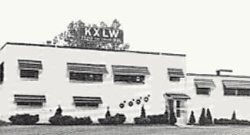Radio Articles
East St. Louis’ Portable Radio Station
It was really the ultimate in portable radio, and it came to East St. Louis in January 1927. Instead of the radio receivers being portable, the radio station was.
The East St. Louis Daily Journal carried a front page story on Dec. 26, 1926, heralding the imminent arrival of WHBM, stating, “Radio station WHBM is going to put East St. Louis on the aerial map.” This claim could probably be chalked up to the bandwagon effect. Across the Mississippi River, St. Louis had several stations operating by 1926, but the Illinois side had none. That’s when Charles Carrell came on the scene.
National radio historian Thomas White traced Carrell to Chicago, which was initially the base of his portable broadcast operations. WHBM was licensed to Chicago at first. Another researcher, Donna Halper, found that it was a popular entrepreneurial move in the 1920s to take a radio station “on the road” to communities like East St. Louis. In her words, “They brought radio to towns that otherwise could not have supported a station.”
WHBM was brought to East St. Louis by the city’s chamber of commerce. A group spokesman told the newspaper, “This company [Carrell] offered us the services of their trained staff of technicians and consultants…we were to be the judges of whether or not such a station would be acceptable to us…”
Carrell’s group did everything right. “Tests” were conducted in late December, broadcasting two programs from the Lyric Theater, with Paul Godt playing the Lyric organ “broadcasting sweet melody.” The newspaper accounts in late December had already begun leading the public to believe that the station may put down permanent roots: “The Chamber of Commerce will gather to discuss the practicability of installing the station here for all time.”
The next day’s issue made the official-sounding announcement on its front page: “WHBM…is to be permanent, following decision of the Chamber today.” It would take to the airwaves five days later from studios in the Chamber of Commerce offices. Chamber manager Les Foreman was named “official announcer” for the station.
Following the official inaugural broadcast, which featured a speech by Mayor M.M. Stephens, the station settled into a daily schedule of variety programs. News bulletins were broadcast by the radio editor of the Daily Journal at 5:30 p.m. each day. After initially carrying articles about the various radio programs for a week, the Journal cut back its daily coverage to a Page 2 box listing the day’s shows and times. By Jan. 19, sponsorships of several programs had been sold and were listed in the box.
Major feature articles ran in Sunday editions, extolling the value of the “advertising” the city was receiving via its radio station. Two months into its operation, WHBM received a letter from a listener in Utah, which was no small feat, considering that the station was broadcasting with 100 watts at 1390 Kc.
By March 20, it was all over. Newspaper articles were now more specific on the initial agreement, stating that “…it [the station] was to be installed here and operated on a trial basis, to ascertain whether the city of East St. Louis would respond to a station of its own…it was agreed that the station would operate during an experimental period up to and including March 20th.” The final broadcast in East St. Louis was March 19, 1927. None of the newspaper accounts of the station, save those at the very beginning, mentioned C.L. Carrell.
Researcher Halper learned that Carrell had been a theatrical impresario in Chicago, overseeing several traveling companies. It was, therefore, no coincidence that many of the WHBM broadcasts originated from the Lyric Theater. It was Carrell’s way of getting publicity for his people, which got more people to go to the theater.
By 1928, the Federal Radio Commission outlawed portables under General Order 30.
As a footnote, only one article about WHBM could be found in the St. Louis Post-Dispatch, and it listed the wrong call letters (WBHM).
(Reprinted with permission of the St.Louis Journalism Review. Originally published 10/98.)





